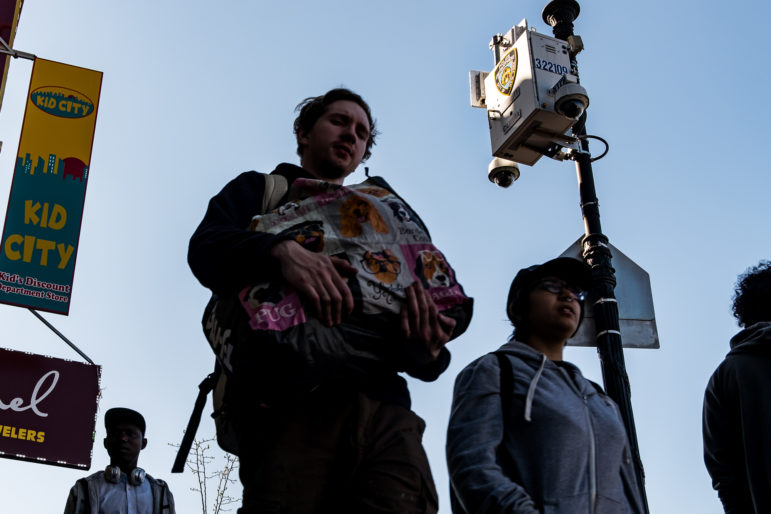
Adi Talwar
An NYPD camera located on East Fordham Road Avenue in the Bronx. Public oversight has lagged as the department’s electronic surveillance capabilities have multiplied.
Four years after the Edward Snowden revelations, New York City and State legislators are proposing legislation that would provide transparency and judicial oversight on the use of surveillance technology by law enforcement.
In the five boroughs, Councilmembers Vanessa Gibson and Dan Garodnick have introduced the Public Oversight of Surveillance Technology Act, which would require the public disclosure of proposed surveillance technology purchases by the NYPD and provide an opportunity for public input into use guidelines and policies for that equipment. On a state level, legislators have introduced two separate bills that would require law enforcement to obtain warrants in order to track or intercept cellphone communications.
New York’s efforts to reign in the use of high-tech police surveillance come on the heels of similar efforts in other states. In California, a state law passed in 2015 requires sheriffs and police to obtain warrants before intercepting phone calls or other communications, or deploying a cell-site simulator—a device that allows police to track and intercept cellphone communications—to locate individuals. Other recent California laws placed restrictions and heightened privacy standards for specific surveillance technologies, such as license plate readers and cell-site simulators. Illinois enacted restrictions on the use of biometric identification technology like facial recognition. That law recently withstood a court challenge from Facebook.
On a local level, East Palo Alto, Oakland, Seattle and Santa Clara County have passed laws requiring public notice and approval by local legislators for the purchase of surveillance technology and the development of use guidelines and privacy policies.
The New York City Police Department, with a headcount of more than 36,000 sworn officers, has more than 1,400 officers devoted to intelligence gathering and counterterrorism, as well as an unparalleled city-wide network of surveillance cameras, license plate readers, gunshot detectors and environmental sensors known as the Domain Awareness System.
The department’s intelligence-gathering practices have been under oversight for decades under the Handschu agreement, which was triggered by the NYPD “Red Squad”—later known as the Bureau of Special Services – spying on thousands of political activists. More recently, the department has taken heat for going out of state to spy on protest groups ahead of the 2004 Republican National Convention, having undercover cops don jean jackets to (rather unconvincingly) infiltrate the Critical Mass bike protest movement and compiling extensive dossiers on the peaceful activities of the city’s Muslim and Arab communities—as well as the controversial “mosque-raking” program that resulted in a federal judge imposing restrictions on NYPD’s surveillance of the city’s Muslim communities.
The NYPD’s Intelligence Division, Counterterrorism Division and Technical Assistance Research Unit (which is heavily focused on monitoring political activity and demonstrations) all devote considerable attention to electronic surveillance as well. However, little is known about NYPD’s actual surveillance capacities and practices beyond the information selectively released by the department. In 2009, NYPD asked the public for insight into the proposed privacy guidelines for the Domain Awareness System, a 24/7 command center where officers view video and sensor feeds from thousands of CCTV cameras, license plate readers, gunshot detectors, and other devices from across the city.
Documents released by the New York Civil Liberties Union reveal the NYPD used cell-site simulators over a thousand times from 2008 through early 2016 to find suspects for crimes ranging from murder to calling 911 too frequently. Roughy 500 automatic license plate readers manufactured by ELSAG corporation are in use by NYPD, according to 2014 testimony to the City Council by Deputy Commissioner of Intelligence and Counterterrorism John Miller. Furthermore, the department also subscribes to a massive private database of 2.2 billion license plate reader records from across the United States maintained by Vigilant Solutions.
Even if cops are looking for a specific phone or car, cell-site simulators and license-plate readers hoover up data on all surrounding cellphones and license plate readers within range of the devices. That raises the possibility that the NYPD has a vast repository of information on New Yorkers, while their use policies and guidelines for those technologies are secret. License plate reader records are retained for up to five years. Certain cell-site simulators, such as Harris Corporation’s Hailstorm device and Digital Receiver Technology’s DRT Box product line, have the ability to intercept phone calls and data transmissions on multiple cellphones. One type of DRT Box can simultaneously geolocate and intercept communications from up to 200 cellphones at once.
Without insight into NYPD’s use guidelines and data retention policies for such powerful surveillance equipment, there is no way to determine how much information the department retains on people who have committed no crime.
Unlike similar measures in other cities, the POST Act does not require Council approval of NYPD’s privacy policies for or purchase of surveillance equipment. In an interview, Garodnick said that the POST act aims to increase transparency without micromanaging the police.
“We didn’t create a formal approval process. We created a formal public engagement process but left the final decision in the hands of the police commissioner,” Garodnick said. “We’re trying to strike the right balance here between the need to not only employ surveillance technology but to respect the NYPD’s prerogatives to use their best judgement.”
The NYPD—which has denied several FOIL requests over the past decade from this reporter for documents and contracts relating to the department’s surveillance cameras, license plate readers, gunshot detection technology, and Palantir data-mining software—is opposed to Gibson and Garodnick’s transparency initiative.
The NYPD did not respond to requests for comment. But at a Queens precinct last month, NYPD deputy legal commissioner Larry Byrne said, “We don’t believe that this bill will become law, but if we have to comply with this bill, the next issue of Inspire magazine that came out after it would be devoted to all of the technology the NYPD uses to prevent terrorist attacks — here’s how you can disable these technologies, here’s how you can avoid these technologies,” according to published reports. Inspire magazine is the English-language propaganda publication of Al-Qaeda. Byrne also claimed that no police department in the United States was bound by such legislation – a fact at odds with the existing civilian oversight of surveillance technology in West Coast cities like Seattle and Oakland.
Currently, the City Council is in the dark about just what technologies the police department possesses, outside of information the department opts to make public. “We don’t even know what types of surveillance equipment they’re using,” said Vanessa Gibson, a Bronx Democrat who chairs the public safety committee. While she does believe that closed-circuit television has contributed significantly to reducing gun violence throughout the city, to the point where there were less than 1,000 shootings in the five boroughs in all of 2016, Gibson said NYPD’s history of conducting surveillance of political activists under questionable legal premises—most recently, of Black Lives Matters organizers—demonstrates a need for external oversight.
“The department has been sued multiple times – the Handschu agreement and the Raza case that was recently settled in federal court. So there are court orders that are forcing the department to provide greater accountability to the public,” Gibson said. “Any efforts that the police department embarks on where they’re impeding people’s rights to protest peacefully is wrong. That’s not the city we should be and it’s not who we are.”
The NYPD’s impending introduction of one new form of technology foreshadows what the broader discourse over surveillance and privacy in New York City could look like if the POST Act becomes law. The city’s rollout of 1,200 body-worn cameras to patrol officers will begin later on April 23 of this year, with 100 cameras to be issued to officers in the 34th Precinct in Northern Manhattan. Over the following year, 1,200 cameras in total will be distributed to ten precincts across the city. The body camera program is a result of court-ordered reforms stemming from Floyd v. City of New York, the class action suit that curtailed NYPD’s stop and frisk practices.
The city did solicit comment from the public during the crafting of the camera privacy policy, receiving input from more than 5,000 police officers and 25,000 members of the public. The guidelines mandate that officers inform anyone they interact with while a body camera is active that they are being recorded, and place restrictions on when officers can view their footage from incidents where they may criminally liable.
However, the POST Act’s deference to NYPD on the final round of policy making and contract approval would not mitigate some of the biggest problems that threaten to derail NYPD’s rollout of body cameras. The contract battle between Axon and Vievu, the two market leaders in body-worn cameras, was extremely contentious, and the city’s Department of Investigation is investigating the bidding process.
Furthermore, privacy concerns exist over the facial recognition capabilities of body-worn cameras, which the NYPD guidelines do not prohibit, officers are allowed to review their video before writing reports, and citizens must either file a FOIL request or go through the discovery process if they are charged with a crime. This week, the Center for Constitutional Rights challenged the body-camera rollout in federal court. Three police unions are also threatening to sue NYPD to block the camera rollout.
The contentious implementation of NYPD’s body cameras is certain to inform the shape of the POST Act, as advocates from communities with more proactive surveillance technology ordinances take notice and begin to weigh in on New York City’s attempt to strike a balance between security and privacy.








